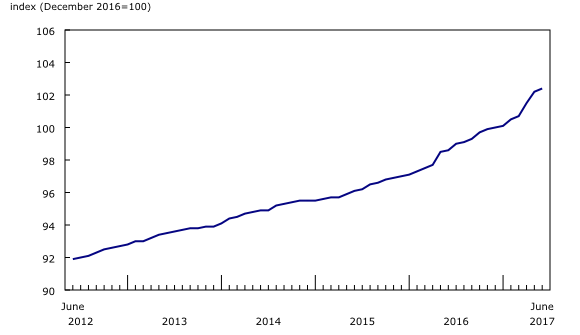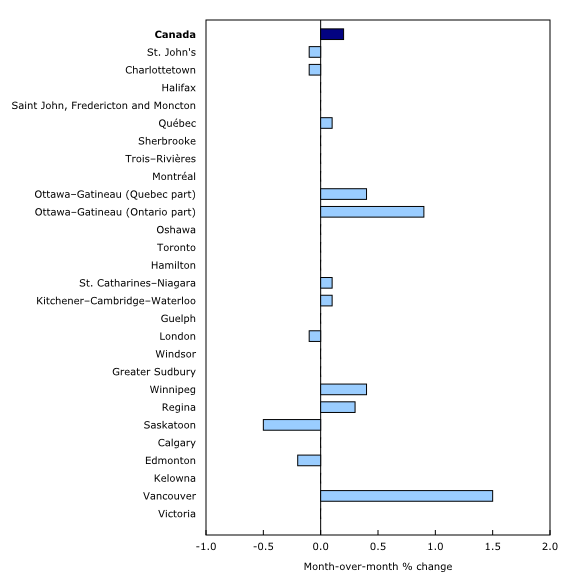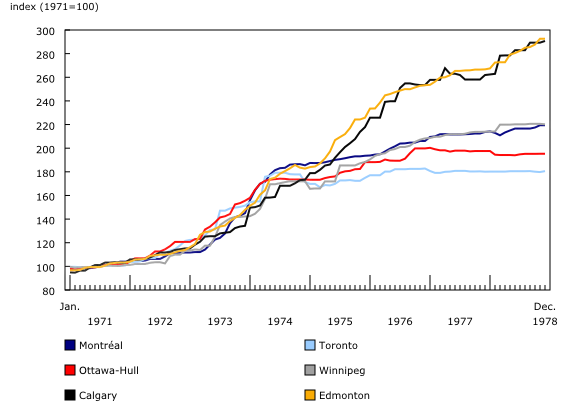New Housing Price Index, June 2017
Archived Content
Information identified as archived is provided for reference, research or recordkeeping purposes. It is not subject to the Government of Canada Web Standards and has not been altered or updated since it was archived. Please "contact us" to request a format other than those available.
Released: 2017-08-10
June 2017
0.2% 
(monthly change)
June 2017
-0.1% 
(monthly change)
June 2017
-0.1% 
(monthly change)
June 2017
0.0%
(monthly change)
June 2017
0.0%
(monthly change)
June 2017
0.1% 
(monthly change)
June 2017
0.1% 
(monthly change)
June 2017
0.4% 
(monthly change)
June 2017
-0.2% 
(monthly change)
June 2017
-0.1% 
(monthly change)
June 2017
1.3% 
(monthly change)
In June, new house prices in Southern Ontario paused from their recent upward climb, curbing the national increase at 0.2%. This was down from a 0.8% increase in April and a 0.7% gain in May.
New Housing Price Index, monthly change
Toronto recorded no change in new home prices in June. The same dynamic was observed in a number of neighbouring census metropolitan areas (CMAs), with only St. Catharines-Niagara (+0.1%) and Kitchener-Cambridge-Waterloo (+0.1%) reporting minimal price increases.
These results follow the introduction of the Fair Housing Plan by the Ontario government in April. The plan includes the 15% Non-Resident Speculation Tax, as well as other measures aimed at cooling the housing market in Ontario.
Vancouver (+1.5%) and Ottawa-Gatineau, Ontario part (+0.9%) were the top contributors to the national gain. This was the largest increase in Ottawa-Gatineau, Ontario part since April 2011. Builders in both metropolitan areas cited improving market conditions as the main reason for the increase.
Overall, prices were up in 8 CMAs, down in 5 and unchanged in 14.
New Housing Price Index, 12-month change
New house prices in Canada rose 3.9% over the 12-month period ending in June, led by Toronto (+8.5%). Other notable year-over-year price increases were observed in Kitchener–Cambridge–Waterloo (+6.5%), London (+6.4%), Vancouver (+6.2%) and St. Catharines–Niagara (+6.0%).
Declines were recorded for five metropolitan areas, with St. John's (-0.9%) posting the largest decrease.

In celebration of the country's 150th birthday, Statistics Canada is presenting snapshots from our rich statistical history.
The new housing price indexes recorded their first period of sustained double digit year-over-year price change in the early 1970s. House price increases were largest in the spring and summer of 1974, with reported 12-month gains greater than 30% for all six CMAs covered at the time (Montréal, Toronto, Ottawa-Hull, Winnipeg, Calgary and Edmonton). As Canada faced rising interest rates and inflationary pressure from higher oil prices, house price increases moderated, with only Calgary and Edmonton continuing to report year-over-year gains of more than 10% until 1977.
Note to readers
The New Housing Price Index measures changes over time in the selling prices of new residential houses agreed upon between the contractor and the buyer at the time of the signing of the contract. It is designed to measure the changes in the selling prices of new houses where detailed specifications pertaining to each house remain the same between two consecutive periods.
The survey covers the following dwelling types: single dwellings, semi-detached houses and townhouses or row homes. The current value of the structure is independently indexed and is presented as the house series. The survey also collects contractors' estimates of the current value (evaluated at market price) of the land. These estimates are independently indexed to provide the published series for land. The index is available at the Canada and provincial levels, and for 27 metropolitan areas.
The prices collected from builders and included in the index are market selling prices less value-added taxes, such as the federal Goods and Services Tax or the provincial harmonized sales tax.
The index is not subject to revision and is not seasonally adjusted.
A Historical Timeline of Canadian Producer Price Statistics
To celebrate Canada 150, "A Historical Timeline of Canadian Producer Price Statistics", part of Statistics Canada — Infographics (11-627-M), was created to showcase the key milestones in the history of Canadian producer price statistics. This historical timeline contains answers to questions such as: Who collected Canada's first statistics? What do Canadian producer price indexes measure?
Infographic: Producer Price Indexes at a Glance
The infographic "Producer Price Indexes at a Glance," part of Statistics Canada — Infographics (11-627-M), demonstrates how producer price indexes for goods and services are calculated and why they are important for the Canadian economy.
Next release
The New Housing Price Index for July will be released on September 14.
Contact information
For more information, or to enquire about the concepts, methods or data quality of this release, contact us (toll-free 1-800-263-1136; 514-283-8300; STATCAN.infostats-infostats.STATCAN@canada.ca) or Media Relations (613-951-4636; STATCAN.mediahotline-ligneinfomedias.STATCAN@canada.ca).
- Date modified:




